.
Zephyros is the wind that blows from the point where the sun sets at the equinox, Aristotle, Meteorologica
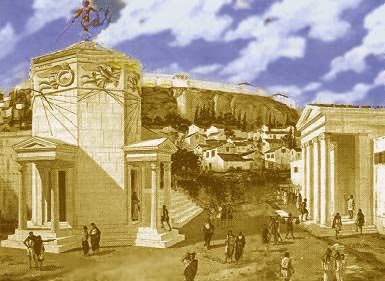
Tower of the winds, Athens (from a drawing in De Solla Price 1967). See color images from a Greek website including a reconstruction of the interior: Drawings, Robert C. Magis, (C) NATIONAL GEOGRAPHIC SOCIETY 1967, PP.593 and additional very interesting historical images.
A Macedonian astronomer, Andronikos of Kyrrhos (or Cyrrhestes), supervised the construction of the Horologion according to Vitruvius, known today as the Tower of the Winds, in the Athens marketplace in the first half of the first century BC. This octagonal structure showed scholars and shoppers both sundials and mechanical hour indicators. The tower with its Doric interior and its Corinthian exterior featured a 24 hour mechanized clepsydra and indicators for the eight winds from which the tower got its name, and it displayed the seasons of the year and astrological dates and periods. The clepsydra inside was driven by water from the acropolis. On the top there was a figure showing the direction of the wind.
In the period 1837 – 1845 the tower was excavated by the Greek Archaeological Society. It was used for some time as a church. Today it is simply called Aerides (Winds)
|
The eight winds on the Tower of the Winds
|
|
|
|
|
|
|
|
|
|
|
|
|
|
But those who are more curious in these matters reckon eight winds; among such was Andronicus Cyrrhestes, who, to exemplify the theory, built at Athens an octagonal marble tower, on each side of which was sculptured a figure representing the wind blowing from the quarter opposite thereto. On the top of the roof of this tower a brazen Triton with a rod in its right hand moved on a pivot, and pointed to the figure of the quarter in which the wind lay. The other winds not above named are Eurus, the south-east wind, Africus, the south-west wind, Caurus, by many called Corus, the north-west wind, and Aquilo the north-east wind. Thus are expressed the number and names of the winds and the points whence they blow. To find and lay down their situation we proceed as follows: let a marble slab be fixed level in the centre of the space enclosed by the walls, or let the ground be smoothed and levelled, so that the slab may not be necessary. In the centre of this plane, for the purpose of marking the shadow correctly, a brazen gnomon must be erected. The Greeks call this gnomon skiaqhvras. The shadow cast by the gnomon is to be marked about the fifth ante-meridional hour, and the extreme point of the shadow accurately determined. From the central point of the space whereon the gnomon stands, as a centre, with a distance equal to the length of the shadow just observed, describe a circle. After the sun has passed the meridian, watch the shadow which the gnomon continues to cast till the moment when its extremity again touches the circle which has been described. From the two points thus obtained in the circumference of the circle describe two arcs intersecting each other, and through their intersection and the centre of the circle first described draw a line to its extremity: this line will indicate the north and south points. One-sixteenth part of the circumference of the whole circle is to be set out to the right and left of the north and south points, and drawing lines from the points thus obtained to the centre of the circle, we have one-eighth part of the circumference for the region of the north, and another eighth part for the region of the south. Divide the remainders of the circumference on each side into three equal parts, and the divisions or regions of the eight winds will be then obtained: then let the directions of the streets and lanes be determined by the tendency of the lines which separate the different regions of the winds. Thus will their force be broken and turned away from the houses and public ways; for if the directions of the streets be parallel to those of the winds, the latter will rush through them with greater violence, since from occupying the whole space of the surrounding country they will be forced up through a narrow pass. Streets or public ways ought therefore to be so set out, that when the winds blow hard their violence may be broken against the angles of the different divisions of the city, and thus dissipated. Those who are accustomed to the names of so many winds, will perhaps be surprised at our division of them into eight only; but if they reflect that the circuit of the earth was ascertained by Eratosthenes of Cyrene, from mathematical calculations, founded on the sun’s course, the shadow of an equinoctial gnomon, and the obliquity of the heavens, and was discovered to be equal to two hundred and fifty-two thousand stadia or thirty one millions and five hundred thousand paces, an eighth part whereof, as occupied by each wind, being three millions nine hundred and thirty-seven thousand five hundred paces, their surprise will cease, because of the number of impediments and reverberations it must naturally be subject to in travelling though such varied space. To the right and left of the south wind blow respectively Euronotus and Altanus. On the sides of Africus, the south-west wind, Libonotus southward and Subvesperus northward. On the southern side of Favonius, the west wind, Argestes, and on its northern side EtesiÊ. On the western side of Caurus, the north-west wind, Circius, on its northern side Corus. On the western and eastern sides respectively of Septentrio, the north wind, Thrascias and Gallicus. From the northern side of Aquilo, the north-east wind, blows Supernas, from its southern side Boreas. Solanus, the east wind, has Carbas on its northern side, and OrnithiÊ on its southern side. Eurus, the south-east wind, has CÊcias and Vulturnus on its eastern and southern sides respectively. Many other names, deduced from particular places, rivers, or mountain storms, are given to the winds. There are also the morning breezes, which the sun rising from his subterranean regions, and acting violently on the humidity of the air collected during the night, extracts from the morning vapours. These remain after sunrise, and are classed among the east winds, and hence receive the name of euros given by the Greeks to that wind, so also from the morning breezes they called the morrow aurion. Some deny that Eratosthenes was correct in his measure of the earth, whether with propriety or otherwise, is of no consequence in tracing the regions whence the winds blow: for it is clear there is a great difference between the forces with which the several winds act. Inasmuch as the brevity with which the foregoing rules are laid down may prevent their being clearly understood, I have thought it right to add for the clearer understanding thereof two figures, or as the Greeks call them schvmata, at end of this book. The first shews the precise regions whence the different winds blow. The second, the method of disposing the streets in such a manner as to dissipate the violence of the winds and render them innoxious. Let A be the centre of a perfectly level and plane tablet whereon a gnomon is erected. The ante-meridianal shadow of the gnomon being marked at B, from A, as a centre with the distance AB, describe a complete circle. Then replacing the gnomon correctly, watch its increasing shadow, which after the sun has passed his meridian, will gradually lengthen till it become exactly equal to the shadow made in the forenoon, then again touching the circle at the point C. From the points B and C, as centres, describe two arcs cutting each other in D. From the point D, through the centre of the circle, draw the line EF, which will give the north and south points. Divide the whole circle into sixteen parts. From the point E, at which the southern end of the meridian line touches the circle, set off at G and H to the right and left a distance equal to one of the said sixteen parts, and in the same manner on the north side, placing one foot of the compasses on the point F, mark on each side the points I and K, and with lines drawn through the centre of the circle join the points GK and HI, so that the space from G to H will be given to the south wind and its region; that from I to K to the north wind. The remaining spaces on the right and left are each to be divided into three equal parts; the extreme points of the dividing lines on the east sides, to be designated by the letters L and M; those on the west by the letters NO; from M to O and from L to N draw lines crossing each other: and thus the whole circumference will be divided into eight equal spaces for the winds. The figure thus described will be furnished with a letter at each angle of the octagon. Thus, beginning at the south, between the regions of Eurus and Auster, will be the letter G; between those of Auster and Africus, H; between Africus and Favonius, N; between that and Caurus, O; K between Caurus and Septentrio; between Septentrio and Aquilo, I; between Aquilo and Solanus, L; and between that and Eurus, M. Thus adjusted, let a bevel gauge be applied to the different angles of the octagon, to determine the directions of the different streets and lanes. Marcus Vitruvius Pollio, de Architectura, See Book 1
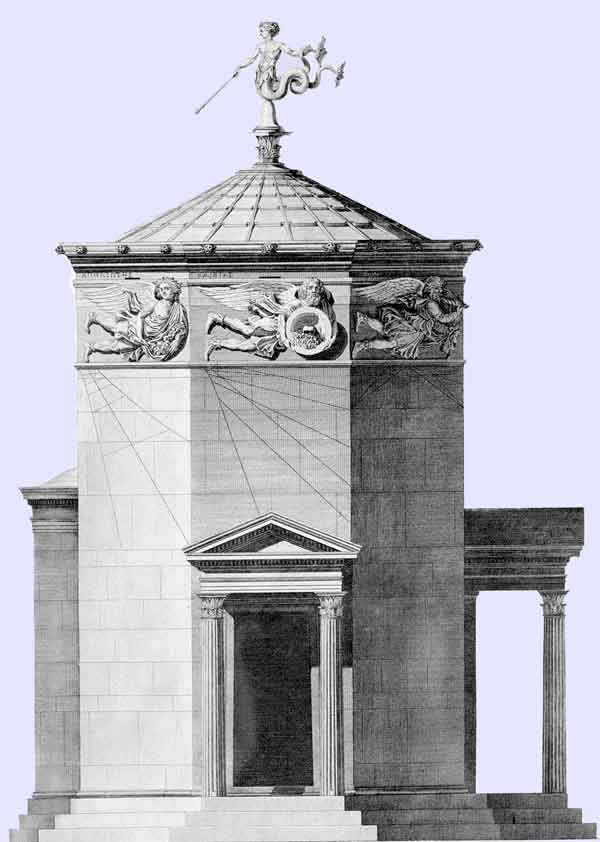
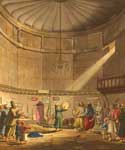
Whirling dervishes inside the tower
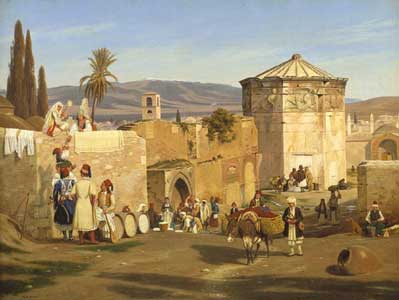
Martinus Christian Wedseltoft Rorbye , 1839
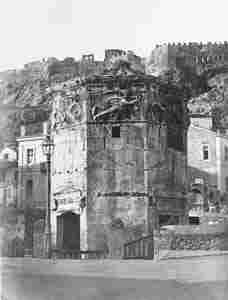
Tower of Winds 1850/80
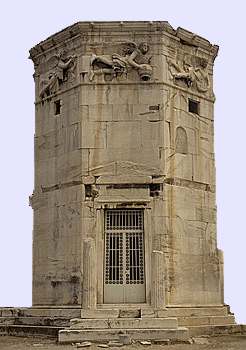
Tower of Winds, a more recent image
Part of Report by VICKI J. YIANNIAS: http://www.greeknewsonline.com/modules.php?name=News&file=article&sid=1365
There is a lot of evidence that the horologist and the architect of the Tower were the same person, said Dr. Kienast, “and he was a very able architect who seems to have had a kind of hobby of dealing with sundials; we have evidence of this from the very highly sophisticated sundial that is in the Sanctuary of Poseidon on the island of Tinos that refers again to Andronikos.” Dr. Kienast emphasized that knowledge of astronomy can be acquired through the study of horology, but that only a trained architect could have such a knowledge of architecture and construction. “So of course, everyone questions where Andronikos was educated, since it is sure that he was not educated at home. Kyrrhos is a rather unknown settlement in Macedonia.” Dr. Kienast feels that Andronikos was educated in Alexandria, “but we have no proof. We have indications that on the great Pharos of Alexandria there was, for the first time, a water clock, and also, the designing of water clocks was a specialty of Alexandria and the natural sciences were developed there.” Dr. Kienast said that the use of the most modern measuring instruments revealed quite a number of gaps in previous knowledge of the Tower, adding that this suggests that there are some interesting surprises still remain.
Taming the Winds .. (Whatever you wanted to know about Greek and Roman Winds... )
The Water Clock, excavations..
John Singer Sargent's The Winds
The Tower of Winds (Hellenic Ministry of Culture)
German Reports
Reports in Greek
Οι Αέρηδες, το ωρολόγιον του Ανδρονίκου του Κυρρήστου , Το ηλιακό ρολόι
ήΡωμαϊκή Αγορά: Το πρώτο εμπορικό κέντρο της Αθήνας
Ο ΠΥΡΓΟΣ ΤΩΝ ΑΝΕΜΩΝ
του Hermann J. Kienast
αρχαιολόγου, Γερμανικό Αρχαιολογικό Ινστιτούτο
Μετάφραση: Όλγα Κολιάτσου
ΕΛΕΥΘΕΡΟΤΥΠΙΑ» - Ιστορικά, 170, (30 – 01 – 2003) Η ΤΕΧΝΟΛΟΓΙΑ ΣΤΗΝ ΑΡΧΑΙΑ ΕΛΛΑΔΑ
| Ancient Greece
Science, Technology , Medicine , Warfare, , Biographies , Life , Cities/Places/Maps , Arts , Literature , Philosophy ,Olympics, Mythology , History , Images Medieval Greece / Byzantine Empire Science, Technology, Arts, , Warfare , Literature, Biographies, Icons, History Modern Greece Cities, Islands, Regions, Fauna/Flora ,Biographies , History , Warfare, Science/Technology, Literature, Music , Arts , Film/Actors , Sport , Fashion --- |

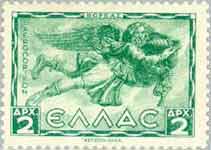
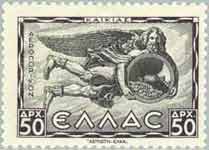
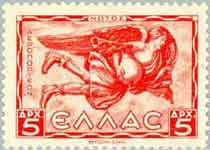
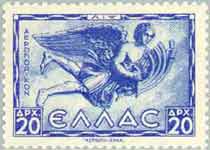
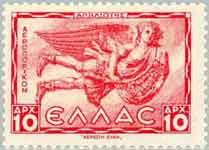

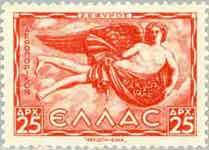 Zephyros (West).
Zephyros (West).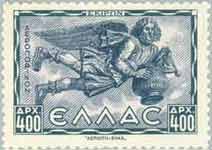 Skiron (North West).
Skiron (North West).